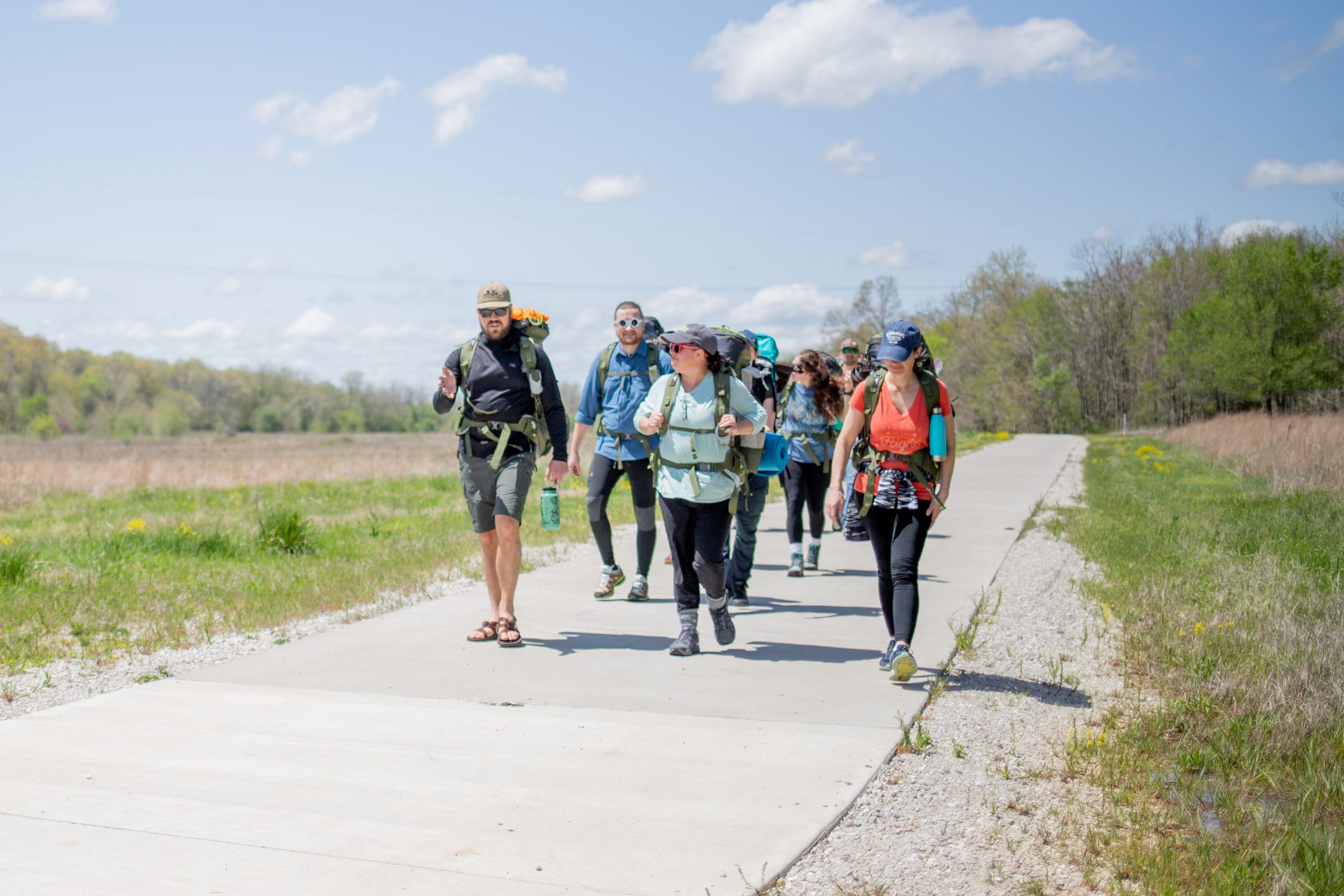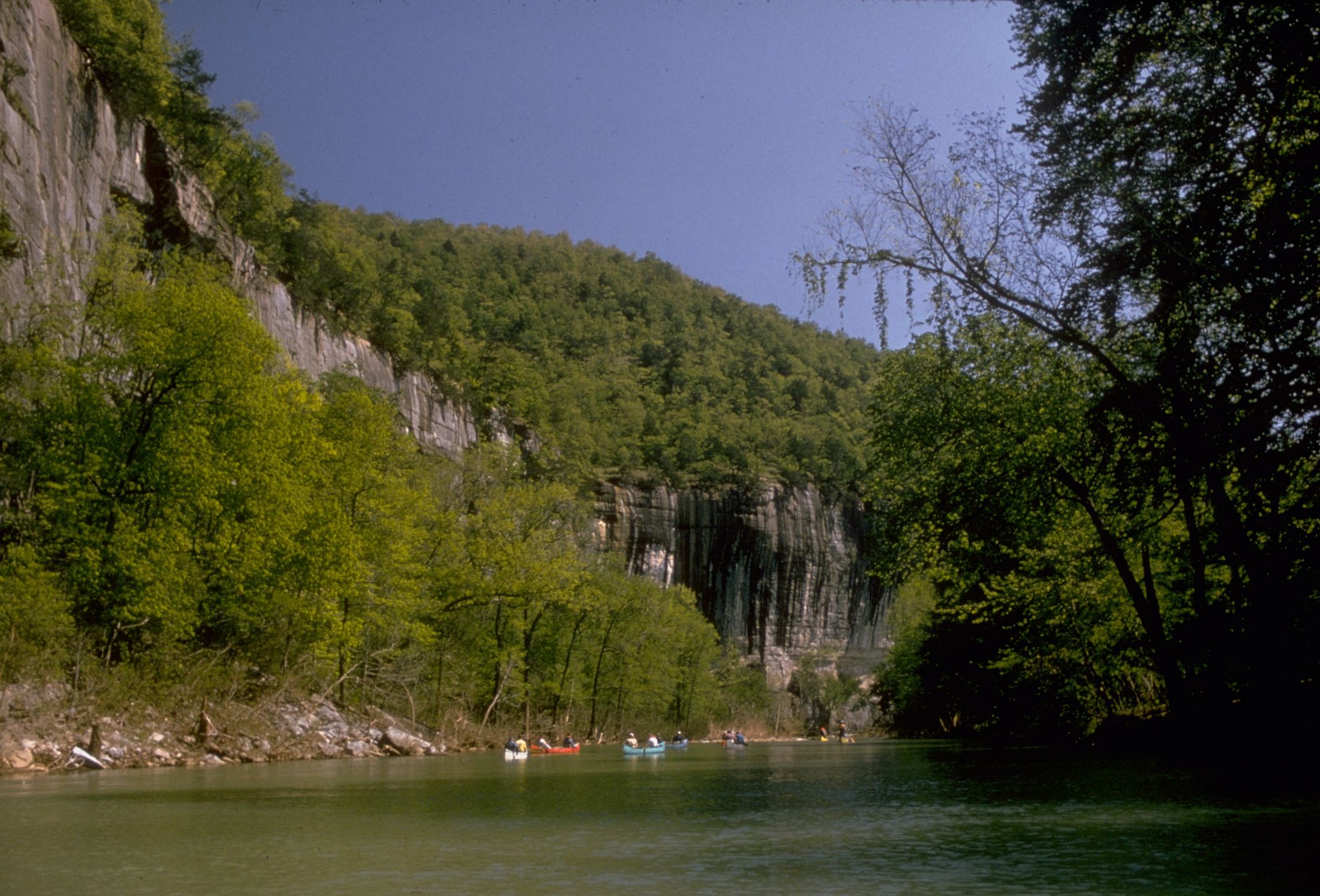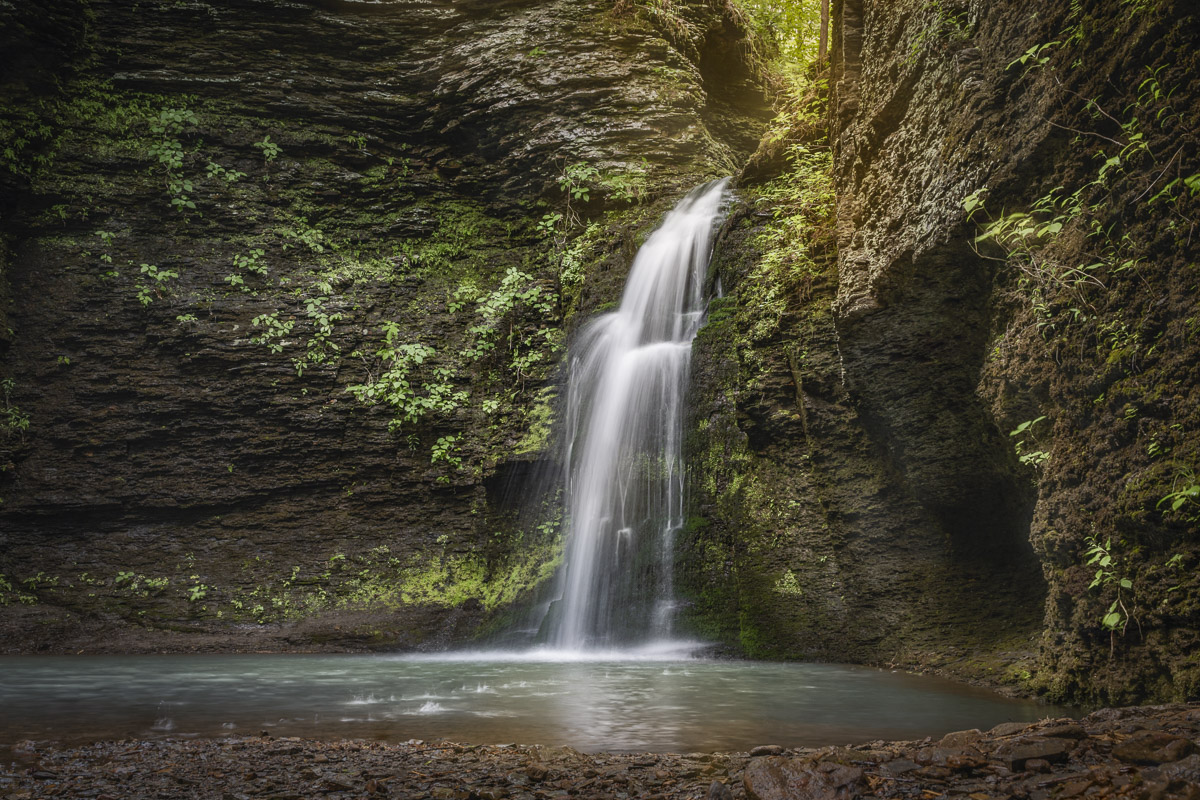Nothing beats heading out for a hike in the Missouri and Arkansas Ozarks outdoors for many area nature lovers. The lure of fresh air, tall trees, meandering creeks, and rushing waterfalls has grown in recent years, with more people using trails nationwide according to one recent study.
Hiking is also social — one reason so many clubs and Meetup groups organize hiking events. People join organized hikes to meet people with similar interests, learn about area trails and to share a mutual appreciation for the wilderness.
However, recent news coverage, social media conversations, and a statement by the Newton County Sheriff’s Office about a Springfield hiker’s tragic, fatal accident on an Arkansas wilderness trail have rattled hiking groups, with some organizers expressing concern — and some choosing to quit leading public hikes altogether.
On May 7, Brad Thomas and others joined a challenging wilderness hike in the Upper Buffalo National River area organized by Jeff Johnson through Arkansas Nature Lovers, a Meetup and Facebook group Johnson established. Thomas and a companion reportedly left the group without alerting Johnson, hiking back alone on the Indian Creek Trail. Along the way, Thomas fell 20 feet to his death.
In a released statement, Newton County Sheriff Glenn Wheeler referred to Johnson as running an illegal, unlicensed and uninsured guide service. However, Johnson and people who hike with him say his group is organized like other social hiking clubs and Meetups.
Hiking with organized groups is a way for people with common interests to experience that together, says Laura McCaskill, who participates in, and leads, hiking and biking activities. “And to characterize it as some professional outfit with liability insurance, or that you’re responsible for those people, is far from the truth,” she says.
Safety at the Buffalo National River: The National Park Service includes links to safety and best practice expectations when recreating at the Buffalo National River, which encompasses more than 94,000 acres including three sections considered designated wilderness areas. The primary message is that recreating in backcountry areas and on a wild river has inherent risks; that hikers and floaters assume responsibility for their own safety; and that rescue is not a certainty. For more information, visit this page on the Buffalo National River website.
One hiking group shut down as a result of the May 7 incident. Hikers are devastated by the accident, says Tammy Kratzer, organizer of the Springfield Hiking Meetup. It didn’t feel right to keep the group active, she says. Plus, she says: “I’m just afraid of the liability of other people.” With a public Meetup group, she may not know every hiker that joins, nor can leaders be expected to evaluate everyone’s skill level. She wonders if volunteer leaders need wilderness or first aid training. “I’ve even thought about liability insurance. We’re not guides. But it’s public, too, and people like to sue.”
Other groups have made some changes or are considering changes. The Ozarks Nature Walks Meetup, based in Branson, recently added a waiver requirement. Doug McKinney, organizer for the Northwest Arkansas (NWA) Hiking Group Meetup, says volunteer leaders in his group are also concerned and discussing whether to make a few changes. “I don’t want to react too quickly,” McKinney says.
(Story continues below)
What are social hiking groups (and what are they not?)
McKinney says the purpose of social hiking groups like the NWA Meetup isn’t commercial. Organizers like himself — and co-organizers who lead hikes — do it because they love to hike and want to share the experience with others.
Jane Hetzel, who leads hikes with the NWA, says participating hikers shouldn’t expect that social hikes for Meetup or club groups are led by paid, licensed guides or vendors. Leaders are typically experienced hikers who know the trails or know enough about an area to organize a hike there. And while many who organize social group hikes may have some first-aid or wilderness training, it’s not a requirement or even common, some leaders say.
They organize hikes with the assumption participants join at their own risk. Most groups include that language in a description; others including the Ozark Society require hikers to sign a waiver. Some, like Johnson, post photos and videos that show what the hike is like. That doesn’t mean the leader and group participants don’t help someone who gets injured or sick, leaders say. In fact, one of the benefits of joining organized hikes is that you aren’t hiking alone.
Many but not all groups request annual dues or fees to participate, a practice that could lead some to believe these groups are more formal than they are. The NWA Meetup requests $10 annually; Arkansas Nature Lovers requested $20. There are out-of-pocket costs to running a hiking group, especially on Meetup.com which charges a monthly fee to the group organizer. That fee can run between $197.88 to $287.88 annually. A help page on Meetup.com suggests group organizers request a membership fee to help offset that cost.
Besides Meetups, other Missouri and Arkansas social organizations hike together. Luke Parsch leads hikes with the Highlands Chapter of the Ozark Society, based in Fayetteville, Ark. The Ozark Society is a conservation organization with seven chapters in the Ozarks including one in Springfield. The Highlands Chapter is among the most active when it comes to organizing hikes. Anyone can belong to the society for an annual fee of $20 to the primary organization, plus $10 to join a chapter. Society fees are not a cost for hiking and non-members can join hikes, Parsch says. Hikes are led by experienced hikers who know the trails but are not professional guides.
Things to know before joining social hikes
Joining an organized social hike is a way for people to enjoy a shared interest, learn about local trails, and meet new people. And there’s a safety-in-numbers factor: It’s not safe to hike by yourself so hiking with a group is a way for individuals to get outdoors. “It’s an opportunity for many people, particularly when they relocate to an area or they don’t have friends or a network that shares that common interest. It allows them an opportunity to share places you might not know about. Which has been very valuable,” McCaskill says.
Many organizations operate in a similar manner: Designated group leaders set a date, time, and destination for a hike, organize the logistics of signing up and where to meet, share details about the trail and what to expect, and then lead the hike once everyone gathers. Before joining a volunteer-led hiking group, hikers should understand expectations. McCaskill suggests joining groups that have clear safety guidelines. For instance, the Springfield group expected members to use real first and last names and post clear profile pictures as a membership requirement.
It’s also important to thoroughly read a hiking event’s trail description. “We put out announcements that are fairly detailed in terms of the basics, like meeting times, to bring lunch, wear boots, we’ll use hiking poles, and usually a description of the hike in terms of scenic features,” Parsch says, “but then also a rating — the hiking distance, elevation gain, any challenging aspects to it like, are we going to be rock-hopping up creeks or is it a trail hike? Is it a bushwhack? We rate it from easy to strenuous or difficult.”
It’s up to hikers to determine their own skill level, leaders say. If hikers aren’t sure, do more research or contact the hike leader and ask questions. McKinney says he’s surprised by how often people show up for hikes and have not read the trail description.
As a hiker, McCaskill has never felt a group leader was responsible for her safety. But she expects a leader and other hikers would come to her aid if she was injured — just as she would aid others. As a hike organizer, she has canceled hikes she felt might not be safe to do because of weather. She and Hetzel say hike leaders usually bring first aid and other safety items. For instance, McCaskill always brings extra energy bars, nuts or water. Hikers should come prepared for hikes, with proper gear and enough water and snacks or lunch to fuel and hydrate themselves, she says: “But I’ve been surprised sometimes with new hikers. Some don’t bring lunch.”
Leaders say if you join a group hike, it’s essential to stay with that group. Hetzel once led a hike where a participant became impatient, decided to hike ahead — and got lost. While members tried to contact rescue services, the hiker showed up. The experience was unsettling for the group. “If you’re the kind of person who wants to go off exploring on your own, then you can’t be on (the group hike)” Hetzel says.
Social Hiking Group Etiquette
We ask social and club hike leaders to share some tips and expectations for hikers who join volunteer organized hikes.
- Respect guidelines, waiver expectations, and rules for the group you join.
- Thoroughly read trail or hiking event descriptions and understand what skill level is expected. If you know you can’t keep up or it’s above your skill level, don’t join that particular hike. If you need more information about a trail, contact the hike leader or do more research on your own.
- Clearly communicate if you plan to join a hike — and likewise, communicate if you decide not to go, even last minute. In addition, make sure the hike leader knows where you will meet the group, whether at a carpool location or at the trailhead.
- If you join an organized group hike, plan to stay with that group. If you insist on leaving the group during the hike, communicate clearly with the leader and expect to be on your own from that point.
- Social hiking groups are a great way to meet other people with similar interests. However, respect social boundaries: Don’t pay unwanted attention to another hiking member.
- Be prepared with the proper gear, such as hiking boots or sturdy shoes; trekking poles if they are recommended; a backpack with enough water, snack, and personal safety gear; layered clothing, and more.
- Don’t bring alcohol on a trail — save that cold beer for the after-hike.
Inherent risks of hiking
But it’s a challenge, say McKinney and other leaders. Hikers are adults and make their own decisions. “It’s not like these are a bunch of 14-year-old kids that we’re looking after. These are adults making decisions about whether they want to go up that hill or not,” McKinney says. “At the least, let someone know that you’re breaking off. And don’t do it alone.”
When it comes to the recreating in wilderness outdoors, Cassie Branstetter, public information officer for the Buffalo National River, says there are always inherent risks. Many trails are in designated wilderness areas that are hard to reach for search and rescue. “Depending on the location where the recreation is occurring, the response of park rangers or any kind of medical assistance can take hours. It’s something to definitely consider.”
She says people see photos and hear stories about the area’s beauty and they want to participate. But if someone suggests a hike, she says, “do your research on that location. Take a peek at our website. Talk to people who have been there, or better yet, call a park ranger.” They want to help people make the safest decisions possible “and park rangers can assist you to see if your skill level matches up with a location,” she says.
New concerns
Arkansas resident Dennis Gundersen owns a cabin for rent near Jasper, Ark., and has hiked several times with Johnson’s Meetup/Facebook group. In an email to the Hauxeda, he expressed concern that legal consequences for Johnson could result in others who lead social hikes fearing personal consequences if anyone gets hurt during their hike activity. That could lead to fewer organized hikes, he says “which would not be a good outcome for anyone, especially as regards to safety.”
McKinney says one of his co-organizers expressed reluctance to continue leading hikes; others are asking questions. McCaskill says the “somewhat litigious rhetoric” as a result of the May 7 accident has been harmful to hiking groups. It also makes her question responsibility for other outdoor volunteer activities, like a bike riding group she organizes. “How far do you take it?” she asks.
Hetzel, who has hiked with Meetups around the country, thinks the sheriff’s statement was an overreaction. Johnson has said he modeled his group around other Arkansas social hiking Meetups and that he requests an annual donation of $20 to offset the cost of Meetup fees and to help recover gasoline costs when he previews trails before organizing hikes. He also says, like other groups, he presents himself as a hike leader, not a professional guide. And that he never mentioned or requested a fee — even an annual fee — on the May 7 hike.
Roughly two dozen hikers who wrote to the Daily Citizen back up Johnson’s claims. Richard Hammerle, who has hiked for years with Johnson, wrote: “I am also a member of several other hiking groups, with people that do hikes in the same manner.” Amy White hikes with Johnson and was on the May 7 hike. She wishes the sheriff had sought statements from hikers in the group that day before issuing a press release. “I have never given Jeff money to hike, nor was I asked on that day to give money, donate money or pay for services,” she wrote.
Summer Hawkins wrote to say she hikes with Johnson’s group and several others like it. “All hikes are at the discretion of the hiker and good details are given about each hike,” she writes. “When you are in Mother Nature, you are agreeing to the risk.”
What to Know About Outdoor Adventure Groups
Before joining a social, club, or conservation organization with volunteer-led group hikes or other outdoor activities, consider the following.
- Does the organization limit the number of people participating in group hikes or other activities? (Some trails can be safely hiked with more people than others.) Meetup.com groups have an RSVP system that allows for limits and waitlists. Facebook-posted public events may be harder to limit.
- Will participating in a social group, club or organization require an annual fee?
- If it’s important to you, ask if group leaders have first aid or other safety training. (In social hiking groups, many are simply experienced hikers who know the trails.)
- Do organizers post detailed descriptions of events with distance and skill level expectations?
- Determine if a group or hiking event fits your style. Will the hike or other activity be fast-paced or conducted with stops along the way? Does the leader point out interesting elements along the trail?
- Understand you assume your own risks when participating in outdoor adventure activities, even with a group, and determine for yourself whether an organized event — whether hiking, biking, floating, or otherwise — requires the skill level you have. Research or ask more questions if you aren’t sure.





